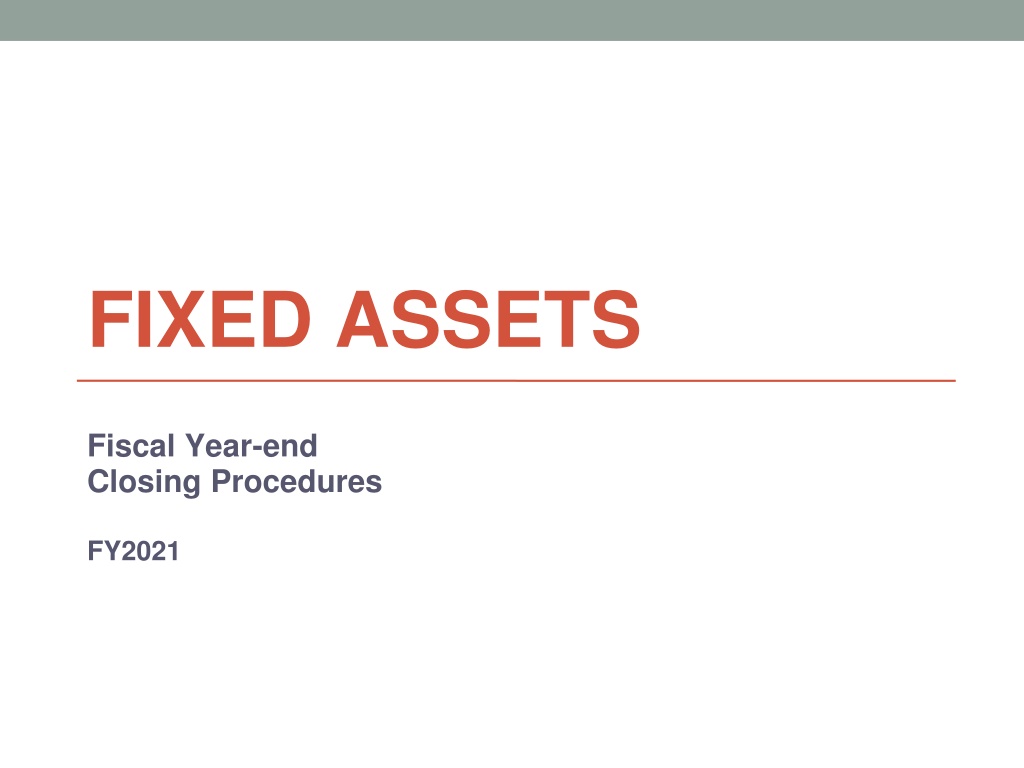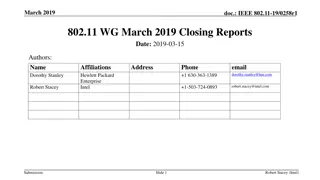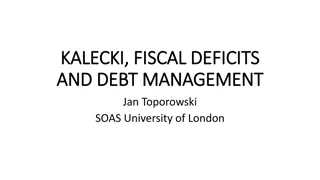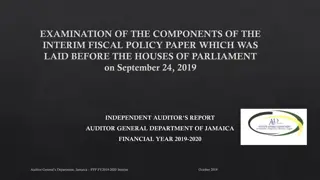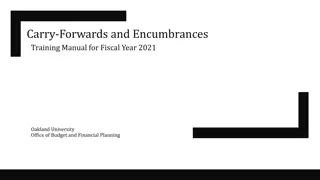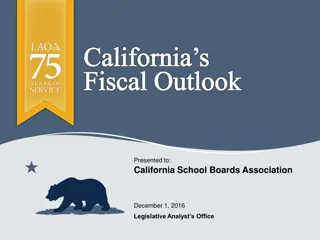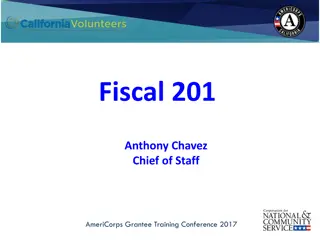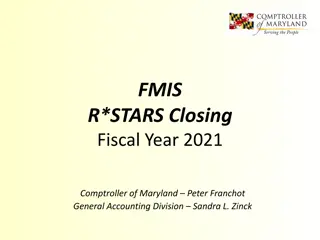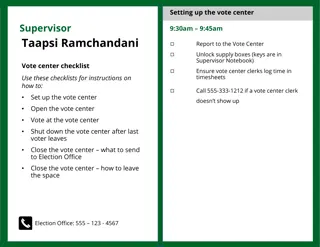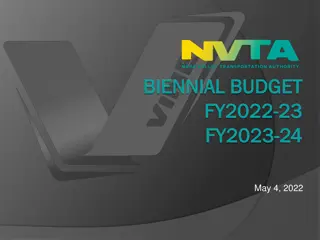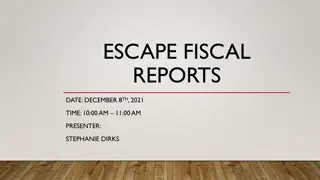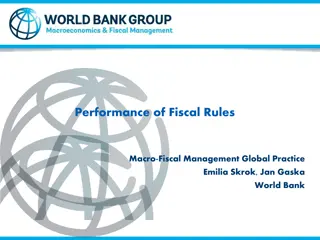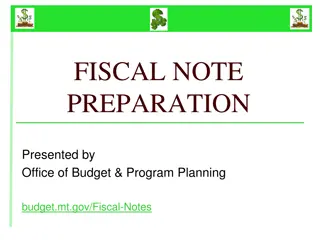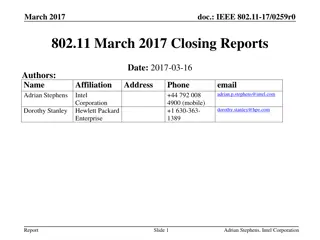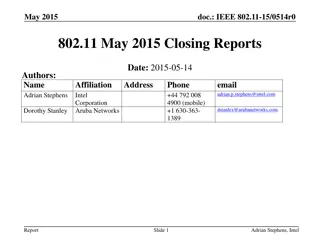Year-End Closing Procedures for Fiscal Year 2021
Conducting the fiscal year-end closing procedures for FY2021 involves tasks such as finishing all current year processing in the EIS system, ensuring items are properly added to EIS based on the receipt date, running reports to verify capitalization thresholds are met, and generating recommended reports for GAAP compliance. Specific guidelines are provided for handling depreciation data changes, verifying capitalization thresholds, and creating various asset schedules in EIS. The process includes running EIS reports for fixed assets by source, function, and class, as well as analyzing changes in capital asset balances during the fiscal year. Ensuring accurate records are maintained is essential for financial reporting and compliance purposes.
Download Presentation

Please find below an Image/Link to download the presentation.
The content on the website is provided AS IS for your information and personal use only. It may not be sold, licensed, or shared on other websites without obtaining consent from the author. Download presentation by click this link. If you encounter any issues during the download, it is possible that the publisher has removed the file from their server.
E N D
Presentation Transcript
FIXED ASSETS Fiscal Year-end Closing Procedures FY2021
2 EIS Fiscal Year-End Closing Procedure Finish all current year processing. Items received on or prior to June 30th,2021 should be added to EIS for FY2021. Items received after June 30thshould added to the EIS pending file for FY2022. If depreciation data has been changed on several items so much that it s necessary to completely recalculate the life-to-date (LTD) depreciation, contact HCC for this process. NOTE: Running EISDEPR will affect items that have had improvements (additional ACQTRNs throughout life of item) causing items to lose their true depreciation history.
3 EIS Fiscal Year-End Closing Procedure Districts with a $ and Life Limit in DATSCN may run an EIS304 Brief Asset Listing to verify all items meeting both the dollar and life capitalization threshold are capitalized. How? In EIS304, select: non-capitalized items select items with an original cost equal or higher than the capitalization threshold. Generates report of items currently not capitalized but exceed the $ threshold. Check each tag to verify the life expectancy is under the life limit threshold and therefore should not be capitalized.
4 Fiscal Year-End Closing Procedure When all items have been entered for the FY, district can run the recommended list of reports (this includes all necessary GAAP schedules). All recommended FYE reports are explained in the upcoming slides. NOTE: EISCD will generate most of these reports
5 Fiscal Year-End Closing Procedure EIS101 Schedule of Fixed Assets by Source ..summary of the original cost of capitalized items by their source (or fund) the items were charged to on PO. Source means the fund the items were originally charged to when purchased . EIS101 uses the PO information from the acquisition record (ACQTRN) to identify the source fund used in purchasing the items. Output file: EIS101.TXT EIS102 Schedule of Fixed Assets by Function and Class .schedule of fixed assets by function and class. Can be generated by function and class, class or a summary by function and class. Creates summary and detail reports. The Book Value on the report is the Original Cost minus the Total Depreciation Output files: EIS102S.TXT and EIS102D.TXT
6 EIS103 Contains changes in capital asset balances during the current FY Creates three reports as listed below: EIS103S is a summary report listing the beginning balance, acquisitions, dispositions, transfers in/out, adjustments and the ending balance in column format. EIS103D is a detailed schedule of changes listing individual tags that make up the acquisitions, dispositions, transfers, or adjustments amounts. EIS103E is an error report. The summary and detail reports will page break on each fund type: fiduciary, governmental, proprietary, and undefined. The GAAP flag must be set to Y to be able to generate this report. For FYE, it is recommended to generate the report 3 different ways (AC, FC & FD). EISCD includes the 3 different ways. Specific entity_IDs can be included or excluded (i.e. NOGAAP)
7 EIS103 - - + + + =
8 EIS GAAP Reports Totals by Fund Type on the EIS101, EIS102, and EIS103 should match when balancing out for the fiscal year-end. Any errors reported on the EIS103E report should be resolved prior to closing the fiscal year.
9 EIS104 Contains changes in depreciation of fixed assets during the fiscal year The EIS104 creates two reports as listed below: EIS104S is a summary report listing the beginning depreciation, continuing items, acquisitions, dispositions, transfers, adjustments and ending depreciation balance in column format. EIS104D is a detailed schedule of changes listing individual tags that make up the acquisitions, dispositions, transfers or adjustments amounts. Reports will page break on each fund type: fiduciary, governmental, proprietary and undefined The GAAP flag must be set to Y in order to generate a valid report. For FYE, it is recommended to generate the report 3 different ways (AC, FC & FD); EISCD includes the 3 different ways May be used as a depreciation balancing tool with the EIS305.
+- + + -+ = -
11 Suggested Non-GAAP Reports EIS303 Inventory Master Listing ..includes all data on file for items; VERY LARGE report it can produce a complete listing of all items or specified subsets (i.e. report of just depreciation information); don t recommend printing out a hard copy of the report. EIS304 Brief Asset Listing .. a one line per item listing of all items on file or subsets; EIS304 reports recommended to run at FYE include capitalized items only and Status Codes of A, N, EH, and EN (with the exception of the disposition report). Brief Asset Listing by fund Brief Asset Listing by function Brief Asset Listing by asset class Acquisitions for current fiscal year Dispositions for current fiscal year Included in EISCD
12 Suggested Non-GAAP Reports EIS305 Book Value (Depreciation) Report ..displays depreciation information listing original cost, salvage value, book value, % of depreciation, and last year of useful life. The date 06/xxxx (where xxxx is FY being closed) is used for the reporting date. EIS305 reports recommended to run at FYE include capitalized items only and Status Codes of A, N, EH, and EN (with the exception of the disposition report). Book Value Report by function Book Value Report by class Depreciation for current FY dispositions by function Depreciation for current FY dispositions by class Included in EISCD
13 Suggested Non-GAAP Reports EIS401 Insurance Values Report ..lists insurable values and replacement cost information for items; insurable values listed reflect the insurance classifications assigned to the item categories in EISMNT/CATSCN; Recommended if the district maintains current replacement cost and/or insurable values on the inventory item records. EIS801 Audit Report ..tracks changes made to the EIS files For FYE, select the Official Option and keep on file for the auditors used as an official audit trail
14 Fiscal Year-End Closing Procedure Run EISCD to generate a standardized set of FYE EIS reports. HCC will make a copy of your EIS data files once you have completed the process. Please put in a Helpdesk ticket. Once you have received notice that this process has been completed then you can continue the closing process.
15 Fiscal Year-End Closing Procedure Run EISCLS Creates EISCLS.TXT which includes ending balances by Fund, Function and Asset Class. (These are the beginning balances for the next year) Creates EISDEP.TXT which is a summary report of the current year s depreciation, posted by fund. Advances EIS last FY closed flag in EISMNT/DATSCN by one year Adds one year s worth of depreciation to LTD depreciation field Updates beginning balance fields for new FY Once EISCLS is complete, they may start entering inventory for the new fiscal year.
16 Fiscal Year-End Closing Procedure If EIS GAAP flag is not turned on, HCC needs to assist in helping the district start up on GAAP by running EISGAAP. EISGAAP: run only once and at the beginning of the GAAP startup year. Sets GAAP flag in EISMNT/DATSCN to Y Creates beginning information fields for each asset (EISITM.IDX) Generates a beginning balance report for the GAAP startup year Once EISGAAP is complete, they may start entering inventory for the new fiscal year.
17 Questions?
